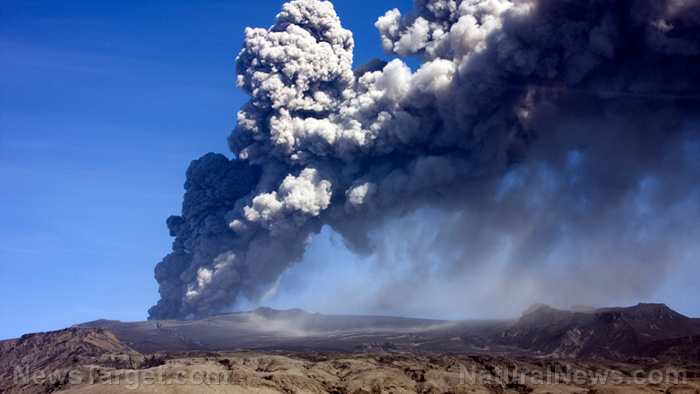Mount Etna’s fiery eruption could reveal hidden mineral wealth
06/04/2025 / By Cassie B.

- Mount Etna erupted dramatically, spewing ash and lava but posing no immediate public threat, offering scientists rare insights into Earth’s deep mineral resources.
- The volcano’s unique lava composition, rich in magnesium and iron, acts as a geological Rosetta Stone, revealing clues about rare earth metals critical for green technology.
- Volcanoes worldwide may hold untapped deposits of rare earth elements, offering a cleaner alternative to environmentally destructive mining dominated by China.
- Iron-rich magma in extinct volcanoes absorbs rare earth metals at much higher rates, potentially revolutionizing sustainable mining practices.
- Etna’s eruption highlights how Earth’s destructive forces also fuel the elements essential for modern technology and energy solutions.
Italy’s Mount Etna, Europe’s tallest and most active volcano, roared back to life this week in its most dramatic eruption since 2014, sending towering plumes of ash and rivers of lava cascading from its southeast crater. While the spectacle captivated onlookers and unnerved nearby residents, the event also offered scientists a rare glimpse into the Earth’s mineral-rich depths, revealing clues that could revolutionize the hunt for rare earth metals critical to green technology and modern electronics.
The eruption, contained within uninhabited areas, produced a powerful pyroclastic flow — a deadly mix of superheated gas and volcanic debris — following a crater collapse. Civil protection authorities swiftly warned tourists to avoid the area, though officials confirmed the lava posed no immediate public threat.
Boris Behncke, a volcanologist at Italy’s National Institute of Geophysics and Volcanology, downplayed concerns, calling the event “relatively normal” for Etna’s volatile nature. Yet beneath the ash and molten rock lies a scientific goldmine: Etna’s unique lava composition, rich in magnesium, iron, and potassium, suggests it taps into both the Earth’s deep mantle and crust, offering unparalleled insights into our planet’s inner workings.
Volcanoes are nature’s mineral factories
Mount Etna isn’t just a marvel of natural destruction; it’s a window into the subterranean forces that shape our world. Unlike most Italian volcanoes, which form through the subduction of the Ionian Sea, Etna’s origins are far more complex. Its lava carries signatures of both mantle-derived elements like magnesium and iron and crustal components like potassium, making it a geological Rosetta Stone for researchers.
This isn’t just academic curiosity. Volcanoes worldwide are now recognized as potential treasure troves of rare earth elements (REEs), the unsung heroes of modern technology. From smartphones to electric vehicle batteries and wind turbines, these metals are the backbone of the green energy transition. Yet their extraction has long been dominated by environmentally destructive mining practices—often controlled by adversarial regimes like China, which currently produces over 60% of the world’s supply.
Recent breakthroughs, however, suggest dormant and active volcanoes could offer a cleaner, more sustainable path. Studies of ancient volcanic systems, like Australia’s Toongi deposit, reveal that minerals like clinopyroxene crystals act as tiny time capsules, preserving clues about where REEs accumulate. As researchers noted, these crystals function like “a tiny crystal ball,” guiding scientists to untapped deposits with minimal ecological disruption.
Iron-rich magma is a game-changer for rare earth mining
Perhaps the most promising discovery comes from extinct volcanoes harboring iron-rich magma. A 2024 study published in Geochemical Perspectives Letters found that simulated iron-rich magma absorbed rare earth metals at rates 200 times higher than conventional magma. Michael Anenburg, the study’s lead author, emphasized that this could explain why mines like Sweden’s Kiruna, located in an ancient volcano, yield such abundant REEs.
“Every one of the iron-rich volcanoes deserves a look,” Anenburg said, although he cautioned that only a fraction may prove economically viable. The implications are staggering: existing iron mines could potentially pivot to extract REEs simultaneously, reducing the need for new, environmentally invasive projects.
Mount Etna’s latest eruption underscores this potential. While its lava flows aren’t directly linked to REE deposits, the volcano’s ability to dredge up deep-Earth materials mirrors the processes that concentrate these critical metals elsewhere. As Darren Orf noted in Popular Mechanics, volcanoes are “engines of creation”—not just for landscapes, but for the very elements powering humanity’s future.
Mount Etna’s fiery display is more than a natural wonder; it’s a reminder that Earth’s most destructive forces also hold the keys to our survival.
Sources for this article include:
Submit a correction >>
Tagged Under:
breakthrough, disaster, discoveries, Ecology, energy supply, environment, fuel supply, green energy, Italy, metals, minerals, Mt. Etna, power, rare earth elements, real investigations, research, volcano
This article may contain statements that reflect the opinion of the author



















